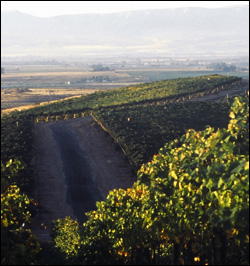For most of its history, Walla Walla, Wash., was known to the rest of the nation as a town with a comically memorable name and for little else. Walla Walla paid little attention. A civilized community where civility was stretched thin over great open spaces, a prosperous community in an area where money’s been growing tighter for the better part of a century, a stable community dominated by families who’ve dominated trade and the professions for even longer. Walla Walla has always known who it was, whatever other people thought. Now that Walla Walla is becoming known and respected not just at home but round the world, the town is taking that in stride, too.
Wine is what’s put Walla Walla on the map, wine that has made the town a destination for tourists—no, make that “travelers,” because people who come to Walla Walla these days know why they’re coming and what to expect when they arrive. Beginning with experimental plantings by scions of old, established farming families like the Figgines and the Smalls, wine grapes have spread across the dusty and rocky soils of the Walla Walla Valley like a beneficent plague. Twenty wineries roost among hundreds of acres of vines south of town to the Oregon border and beyond. Half a dozen more occupy old warehouses near the airport; half a dozen tasting rooms dot the decorous early 20th-century downtown. Among them are names—Leonetti, l’Ecole No. 41, Woodward Canyon—that are often seen in magazines and newsletters devoted to the world’s great wines.
The site of a nationally respected, 120-year-old liberal-arts college (named for the pioneering missionaries Marcus and Narcissa Whitman), Walla Walla has always been something of a cultural oasis in Eastern Washington. The coming of the wineries has made it a pretty good place to eat as well as drink. Restaurateurs tired of the frenzied competition for customers in Seattle and other big cities have settled in Walla Walla and set up restaurants that aim high, searching out fresh local ingredients and developing menus good enough to put beside the remarkable wines the region at its best produces. Jamie Guerin’s Whitehouse Crawford, which shares elegantly remodeled factory quarters with premium Seven Hills Winery, is fast developing a national reputation through word of mouth alone for its superb nouvelle-Américaine cuisine.
Lodging has also grown more traveler-, as opposed to tourist-, oriented. Bed and breakfasts are abundant, for those who enjoy their intimacy; one, the Inn at Abeja, transcends the category in the polished amenities of its winery-side appointments. Downtown, the old and dignified tower of the Marcus Whitman Hotel has sprouted a skirt of convention and conference facilities but remains a reminder of more spacious days.
This summer, even the most wine- oriented visitor may want to pay some attention to another Walla Walla distinction, its connection to the Lewis and Clark Corps of Discovery, which passed through the Palouse and Snake River country going and coming in the fall of 1805 and spring of 1806.
In addition to its role as a destination in its own right, Walla Walla serves as a satisfactory terminus for explorations of more diffuse regions of Washington’s extraordinary wine bounty. Wineries large and small cluster near Interstate 82 between Union Gap and Benton City in the lower valley of the Yakima River.
Walla Walla can also be a jumping-off point for a venture down the Washington side of the Columbia (incomparably more scenic than the Oregon side) to the state’s newest vinous hotbed between Maryhill and Bingen, where a number of younger winemakers are doing wonders, particularly with hot-country grape varieties, on the enormous variety of soils and climate zones offered by the precipitous cliffs of the Columbia Gorge. (Once there, it’s a quick trip over the river to Oregon’s lush orchard and wine country along the Hood River.)
Of course, one can enjoy the amenities and product of many Washington wineries without traveling any farther than Woodinville, where the two giants of the Washington trade, Chateau Ste. Michelle and Columbia, preside with dignity over a Sammamish Valley–ful of smaller labels. But one doesn’t really appreciate the astonishing fact that Washington is becoming a name in world wine as well known, if not respected, as Germany’s Mosel, France’s Loire, Italy’s Piemonte. And the capital of Washington wine, from a world perspective, is Walla Walla, comic no more.








